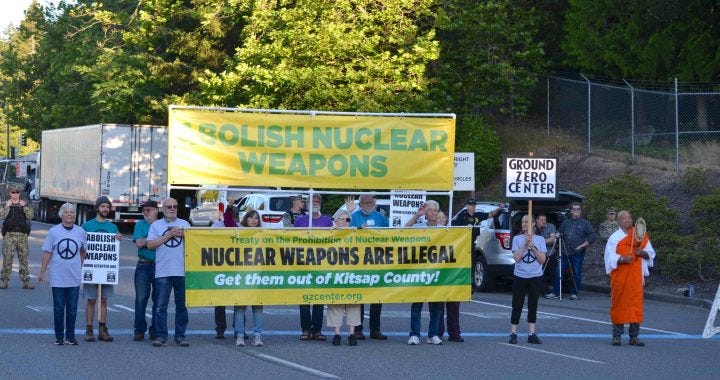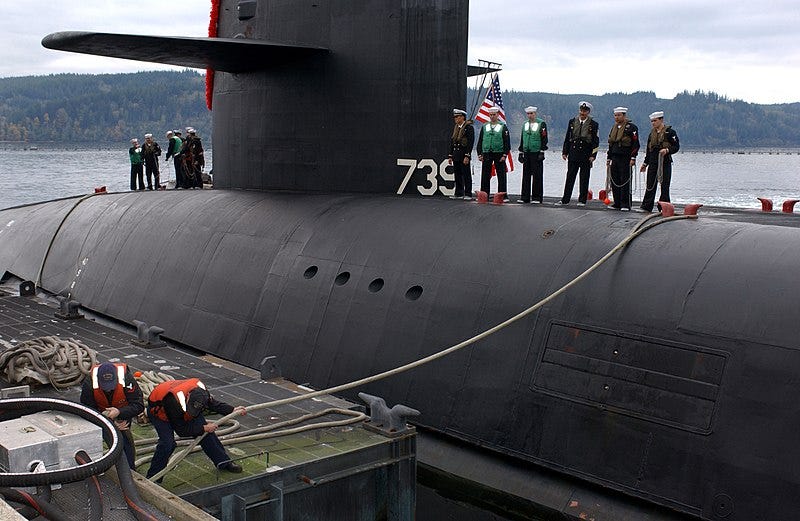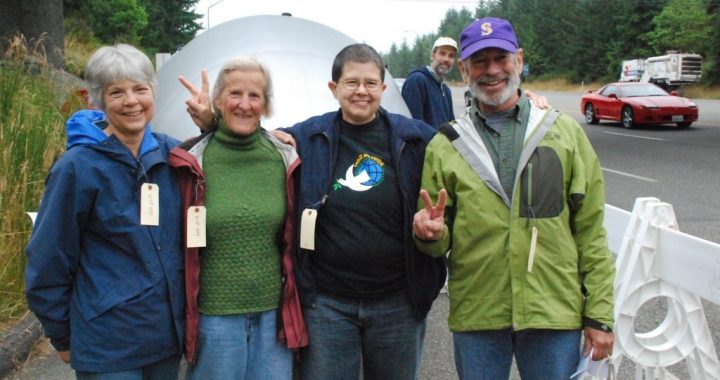Only way to prevent their use, says Tom Rogers – Get rid of them
By Patrick Mazza; Originally published in The Raven; October 7, 2022; https://theraven.substack.com/p/from-nuclear-sub-commander-to-nuclear
From handling nuclear weapons to protesting them
Tom Rogers knows his way around a nuclear weapon.
At various points of his career as a U.S. Navy submarine officer, he oversaw safety and security of nuclear weapons on board, conducted disaster drills, and was part of the team that would authenticate orders to use them. Rising to captain a sub, he was responsible for the whole picture.
Later in his career, Rogers began to raise his voice against what he saw as a national security strategy flawed by its reliance on weapons that would cause a global holocaust. After he retired, he became an advocate for nuclear weapons abolition, and has been arrested at least 10 times blocking the gates at the Trident submarine base in Bangor, Washington, site of the largest concentration of deployed U.S. nuclear weapons.
There is no such thing as a limited nuclear war, Rogers says. “It’s a fallacy if to think you can control a nuclear war. It’s use them or lose them. That’s the fallacy of relying on nuclear weapons.”
“It’s only a matter of time until by miscalculation or accident a nuclear weapon gets used. Because of the way the strategy is written, you don’t shoot just one nuclear weapon. You don’t see just three coming over the horizon. You see 3,000. The only way to prevent that carnage is to get rid of them.”
Coming to question a flawed strategy
In 1966, Rogers received his draft notice. Looking for an alternative to an Army tour in Vietnam, he stopped by a Navy recruiting office and signed up. With a couple of years studying engineering in college, he opted for training to run submarine nuclear power plants. Doing well at that, he was selected for officer training. Completing his engineering degree and training, Rogers was commissioned and went back to the sub fleet.
Over the next 26 years, he would serve on four nuclear subs, including one ballistic missile submarine and three attack vessels. All were armed with nuclear weapons. Attack subs could launch nuclear-tipped rockets from their torpedo tubes before nukes were taken off all Navy ships, except the ballistic missile subs, after the 1991 collapse of the Soviet Union. Rogers rose through the ranks to captain the USS Pogy from 1988-91, and then became a staff officer stationed at Pearl Harbor, working on what he can only describe as “sensitive submarine operations in the Pacific.”
“That was where I really questioned where we were going with strategic plans,” Rogers says. With the Cold War over, “I would ask admirals, why we are building up when we should we building down? They would answer that regardless of the Russians’ intentions we have to be mindful of their capabilities so we can’t afford to reduce our capabilities below theirs. That was bullshit in that what I believed and still believe is that the national security strategy is written by defense contractors and high ranking officers that are going to go to work for defense contractors and lobbyists. It is the military-industrial congressional complex that determines the national security strategy. Every weapons system that is eliminated is a loss of revenues.”
Over the last three years before he retired in 1998, Rogers was stationed to San Diego as part of an elite team teaching admiral-level battle group commanders prior to their deployment. “In that role I had a lot of access to a lot of people. I spoke out about using nuclear weapons as primary national security strategy. I spoke out in the Navy, never publicly. I never would make admiral, but they couldn’t get rid of me.”
After retirement, Rogers was enraged by a prime example of that military-industrial-congressional complex at work. Eighteen Trident ballistic missile submarines had been built, but the first 8 were obsolete. The Navy planned to decommission the subs. “Congress wouldn’t let them,” and forced a costly overhaul of 4 of the subs to carry more advanced nuclear missiles, and another 4 to carry conventionally-armed cruise missiles. “That’s what got me to Ground Zero, out of my idyllic retirement. I’ve been an activist since 2002.”
At Ground Zero, resisting since 1977
Rogers is referring to the Ground Zero Center for Nonviolent Action located in Poulsbo, Washington, near where the 75-year-old currently lives. It is within what would be the blast radius if a nuclear weapon were to strike the nearby Trident base. “That’s why we call it Ground Zero,” he says.
Ground Zero was founded in 1977, and purchased land adjacent to the naval base already there, where plans to base the Pacific Trident fleet were already underway. (The other base is at Kings Bay, Georgia.) The group viewed the Trident as a particular threat. The 7,000-mile-plus range and pinpoint accuracy of Trident missiles made them potential first-strike weapons.
Nonviolent resistance began immediately. Led by Ground Zero founders Shelley and Jim Douglass and their compatriots, hundreds were arrested protesting the Navy’s seizure of farmland to expand the base. Thousands were on hand on land, along with a flotilla on the water, to protest the arrival of the original sub, the USS Ohio, in 1982. Through the 1980s, protestors blockaded the routes of “White Trains” carrying Trident missile warheads from their assembly point in Amarillo, Texas to Bangor.
Then Seattle Roman Catholic Archbishop Raymond Hunthausen would say in 1981, “Trident is the Auschwitz of Puget Sound because of the massive cooperation required in our area — the enormous sinful complicity that is necessary — for the eventual incineration of millions of our brother and sister human beings.”
That kind of call to spiritual resistance and responsibility has been at the heart of Ground Zero since its inception. The group opens its webpage with the statement, “Ground Zero Center for Nonviolent Action offers the opportunity to explore the meaning and practice of nonviolence from a perspective of deep spiritual reflection, providing a means for witnessing to and resisting all nuclear weapons, especially Trident. We seek to go to the root of violence and injustice in our world and experience the transforming power of love through nonviolent direct action.”

To that end, Ground Zero stages three nonviolent actions at the Trident base each year, in January commemorating Martin Luther King’s birthday, in May on Mother’s Day, and in August to remember the nuclear bombings at Hiroshima and Nagaski. This past August, 40 people blocked the gates at the sub base and 13 were arrested to note the 77th anniversary of the bombings.
“I’ve been arrested at least 10 times. I haven’t kept track,” Rogers says. “It’s an opportunity to use the court as a public forum. I’ve done mitigation hearings explaining why I did why I did, asking the judge to throw out the citation.” He has been successful in that several times, and when fined it has always been reduced “to a pittance.”
“What have we accomplished? That’s what people ask,” Rogers adds. “Why are you wasting your time? But that’s all we can do, being that small voice. You get enough small voices. Our government has to listen.”
Trident and its dangers
Nuclear war would be a global disaster, immediately killing many millions by blast and radiation, and over subsequent years bringing death to billions as black soot spewed into the stratosphere by nuclear fires crashed agricultural production and caused global famine. In recent years, studies have shown that the small arsenals held by countries such as India and Pakistan could cause a nuclear winter, let alone the massive stockpiles held by the U.S. and Russia.
Nonetheless, I have a personal dog in this hunt, in that I live in Seattle 20 miles east of the Bangor base. Even in a so-called counterforce war, where each side only struck military targets and left cities intact, I am my loved ones and friends would be shrouded in a cloud of radiation. Painful death in the immediate aftermath or from cancer in subsequent years would be likely, even if we survived the nuclear exchange. So I have had a grim curiosity about what’s at the Bangor base. Tom Rogers filled me in.

Officially known as Naval Base Kitsap-Bangor, the base is home to 10 Trident subs. Eight are ballistic missile launchers, while two are those conventionally-armed subs. Two to 4 nuclear-armed subs are out at sea at all times. Each ballistic missile submarine has 24 launch tubes, though only 20 are filled with missiles due to limitations under the Strategic Arms Limitation Treaty, START. Each missile could be armed with 8 independently targeted warheads, but under START is limited to 4 or 5. It is believed each missile contains a mix of one W88, a 455-kiloton monster, and 3 or 4 W76 90-kiloton weapons. It is also believed each sub also has 1 or 2 W76-2s, a so-called “usable” nuclear weapon with “only” 8 kilotons, regarded by many as a “senseless danger.”
Rogers estimates that the Trident fleet at Bangor carries around 135,000 kilotons, or 135 megatons, of nuclear weaponry. In other words, each sub carries well over 1,000 times the nuclear firepower of the 15-kiloton bomb that destroyed Hiroshima. If recent nuclear winter studies based on computer climate modeling are correct, each Trident has over 10 times the weapons needed to set off a nuclear winter. Altogether, an estimated 1,300 nuclear warheads are situated at Bangor either in submarines or in reserve in an underground bunker. That is more than the 1,000 warheads held by all 7 nuclear states beyond the U.S. and Russia. It is the largest concentration of active U.S. nuclear warheads anywhere in the world.
The road to nuclear abolition
The START treaty, first negotiated in 1991 and re-upped in 2021 for 5 years, limits the U.S. and Russia to 1,550 deployed warheads each. But it sets no limits on reserves. The Bulletin of Atomic Scientists estimates the U.S. holds nearly 2,000. Rogers points to the danger in that. START is only scheduled to run through 2026, after which reserves could quickly be brought out of storage. Those additional tubes on submarines could be filled, and more warheads added to each missile. At the same time, reserve warheads could be added to ground-based ICBMs and mounted on bombers.
“That could happen very quickly,” Rogers says, emphasizing that the next START agreement must reduce reserve as well as deployed forces. Rogers has developed a pathway to nuclear abolition, in which both the U.S. and Russia would reduce total stockpiles to 500 weapons each, which he describes as a “minimum viable deterrent.” Because ICBMs are the most vulnerable, forcing a rapid “use it or lose it” response, those should be eliminated along with most of the bomber fleet, leaving most weapons in the harder to detect subs.
But that would only be a step toward total abolition by the U.S. and the other nuclear powers, China, France, Britain, India, Pakistan, Israel and North Korea. Once the two major nuclear powers together holding over 90% of the world’s nuclear weapons agree to rid themselves of theirs, other powers would readily eliminate their stockpiles, Rogers believes.
One fear about abolition is that a state could secretly build nuclear weapons and gain an advantage over all others. But Rogers is confident that a regime of pervasive inspection and verification would eliminate that possibility. That is already provided under START. Unfortunately, on-site inspections were suspended due to the covid pandemic and current U.S. sanctions are preventing Russian inspectors from entering the U.S. to resume those protocols. It is uncertain whether a new treaty can be negotiated before 2026, but the Russian news outlet RT this week reported that, based on Russian Foreign Ministry statements, backchannel communications have been opened and “significant progress” has been made toward resuming inspections, a step toward negotiating a new treaty.
Rogers will present his scenario in a new presentation, “Nuclear Weapons: From Opposition to Abolition,” at Ground Zero Center following the group’s annual meetingwhich takes place October 22 from 10 am to 12:30 pm. The public is invited to both events.
Building the abolition movement
I first met Tom Rogers a few weeks back when he spoke at the September 24 Seattle Rally for Nuclear Abolition at Cal Anderson Park in Seattle, the first such event in Seattle since 2010. It was followed by a march to the Henry Jackson Federal Building on 2nd Avenue. In his talk he detailed his scenario for building down and eventually abolishing the nuclear arsenal.
The event was lightly attended, only around 100. Like me, most were older folks who in our younger days showed up at ‘60s demonstrations against the Vietnam War or ‘80s nuclear freeze rallies. Even fewer made it down to the federal building. When I later interviewed Tom, we commiserated about that a bit.
The U.S. movement against nuclear weapons is “lily-white 1960s people who are now grayheads,” he said. “Reaching out and finding allies in all of the younger demographics is something I spend a lot of time thinking about. We at Ground Zero are trying to reach out on social media. We don’t get much interest from younger people or people of color. At Cal Anderson, there were 1 or 2 people of color in the demonstration. I don’t know the answer to that.”
I shared a bit of my personal experience as a long-time participant in a movement to stem that other great threat of global immolation, albeit slower moving, climate disruption. To my mind, climate chaos and nuclear war are the two towering challenges facing humanity. If we don’t overcome those, not much else will matter. In the early days in the late 1990s and early 2000s, the climate movement was largely composed of middle age and older white professionals, with limited traction among youth and people of color. In recent years, that has profoundly changed. Young people and diverse faces are at the leading edge of the climate movement. With nuclear war dangers coming to the foreground in ways not seen in decades, the nuclear weapons abolition movement certainly has a similar potential.
At a deeper level, I wonder if we can overcome the many critical challenges confronting us without a broad movement that addresses them together, targeting their common basis in who holds power in society. Tom provided a key clue when he told me we will not dislodge that military-industrial-congressional complex that perpetuates the arms race without campaign finance reform. A parallel to that is fossil-industrial-congressional complex that holds back action sufficient to address the climate crisis. The control of our political and governmental processes by powerful interests is at the root of all our major challenges. It will, I believe, take a broad movement spanning much of the political spectrum to overcome them.
In the meanwhile, we must dramatically elevate the call for abolition of the world’s nuclear arsenals. As Rogers says, if we don’t rid ourselves of them, they will inevitably be used. As he concluded his talk at Cal Anderson, “Imagine the total elimination of nuclear weapons! Peace is possible.”
(I did not cover the danger of accidents in nuclear weapons handling at the Bangor base, such as one that took place in November 2003, in this article. Glen Milner of Ground Zero has published a good article on this. Go here.)
Editor’s Notes: The banner photo is of Tom Rogers, with fellow nuclear weapons resisters, left to right, Anne Hall, Brenda McMillan and Betsy Lamb, after being cited for blocking the Main Gate at the Trident submarine base in Bangor, Washington (photo by Leonard Eiger). Patrick Mazza is a veteran journalist and activist who has worked on a range of issues in peace, justice and environment. You can find his work at The Raven ( theraven.substack.com )




